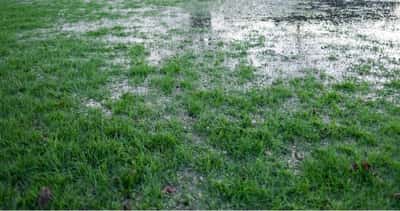You were busy and forgot your lawn mower outside during a big rainstorm. Now you’re worried it may be damaged. A lawn mower is a significant investment you need to protect.
Most likely, you didn’t cause significant damage to your riding mower. However, there are some steps you should take when your mower has been left outside in a heavy rain.
It is okay for a riding lawn mower to get wet. Riding mowers are built to withstand light rain. When a mower is left outside during a heavy rainstorm, moisture needs to be removed from the mower and its electrical components to avoid damage.
A riding mower left in the rain may not start because of water in the engine oil or fuel tank. The mower may also not start because you have water in the electrical components including the ignition switch, spark plug wires, and safety switches.
Below I will list the items you should address after your riding mower gets soaked to keep it operating at its best.

This post may include affiliate links. Purchases made through these links may provide a commission for us, at no extra cost to you. As an Amazon Associate, we earn from qualifying purchases.
Follow all safety instructions provided in your equipment operator’s manual prior to diagnosing, repairing, or operating.Consult a professional if you don’t have the skills, or knowledge or are not in the condition to perform the repair safely.
Steps to Complete When Your Riding Lawn Mower Gets Wet
Dry Out Your Wet Riding Lawn Mower
Dry out your riding mower to remove water. What you are trying to do is get all moisture out of your riding mower, especially around the electrical components, wiring, cables, and switches.
I find it’s best to use a leaf blower to get the mower as dry as possible and then place it outside in the sun, if available, so the heat of the sun can evaporate any remaining moisture.
Check for Water in Your Engine Oil
When the rain comes down very hard, water can get into your engine oil. Check your oil to see if there is a milky appearance that develops when there is water in your oil. It may be helpful to grab a flashlight to check the oil.
If your oil appears milky, perform a routine engine oil change. Find steps for an oil change in my riding mower maintenance guide.
Check Your Riding Mower Air Filter
Next, check out your air filter. If you found water in your engine oil, the water most likely entered the crankcase through the air filter. You can attempt to dry out your paper air filter by letting it air dry.
An air filter that has gotten wet has been compromised and won’t give you the protection you need. I recommend replacing your air filter with a new one.
Check for Water in Your Fuel Tank
Hard rain can cause water to get into your fuel tank through the vent on the fuel cap. Water in your fuel tank can cause your riding mower to run rough or not start because water is not combustible.
When water is found in your fuel tank, you must drain the tank and refill it with fresh fuel
- Drain your riding mower’s fuel tank
Use a siphon hand pump to remove gasoline by placing one end of the hose into the fuel tank and the other end into a fuel container for recycling. Pump the hand pump to begin removing fuel from the tank. - Replace your fuel filter and refill it with fresh fuel
Use a fuel additive like STA-BIL or Sea Foam to reduce moisture in the fuel system to take care of any remaining water. I use Sea Foam in every tank of fuel to stabilize my gasoline and remove moisture since gas only has a shelf life of about 30 days before it begins to break down. Check out the advantages of Sea Foam.
Check for Water in Your Carburetor
If you found water in your fuel tank and you ran your mower, chances are you have water in your carburetor. Remove the screw at the bottom of the bowl and remove the bowl. Have a rag available to catch the gas and water mixture. Replace the empty bowl.
Check Your Riding Mower Electrical Components
Look at the electrical components because they are items that can collect water and cause your mower to have running issues because of bad connections.
Using WD-40, spray your ignition switch to displace water on the connections. Next, do the same with your spark plug wires, spark plug boots, and switches.
Lubricate Your Riding Mower Cables
Spray your riding mower cables with WD-40 to displace moisture that can cause the conduit of the cables to rust up and no longer move freely. Continue to do the same with all wires on your mower that collected water.
Best Place to Store Your Riding Mower
The best place to store a riding mower is indoors and out of the weather elements. This could be in a garage or a storage shed. Never store your mower in your home, basement, or next to any ignitable items.
If indoor storage is not an option you have available, use a marine grade cover when storing outdoors to protect your riding mower from hard rains and sun exposure.
Still Having Problems With Your Riding Mower?
As a lawn mower owner, when you own it long enough, you are going to run into different types of problems. This may include problems where your riding mower is smoking, cutting uneven, losing power, not starting, leaking fuel, and more.
Check out this handy guide including charts for common riding mower problems and solutions:
Common Riding Lawn Mower Problems & Solutions.
If you are unable to fix your riding mower or don’t want to attempt a more complicated repair, have your local lawn mower dealership or repair shop for assistance.
